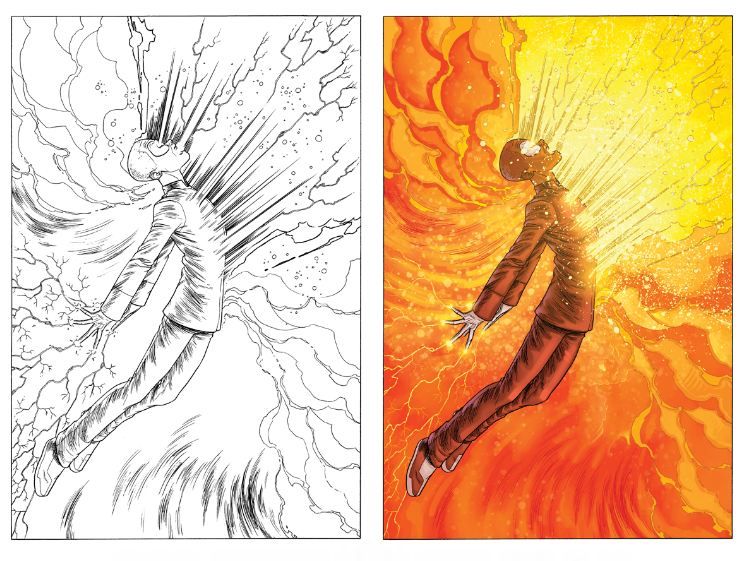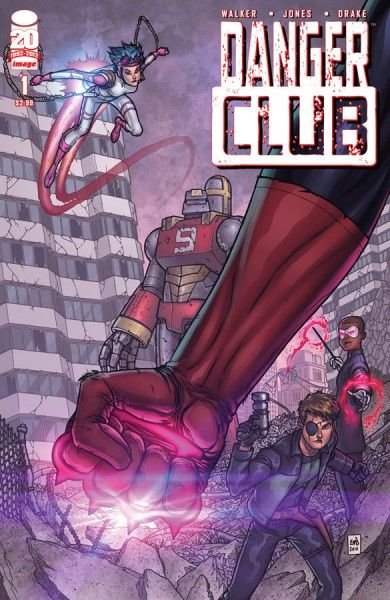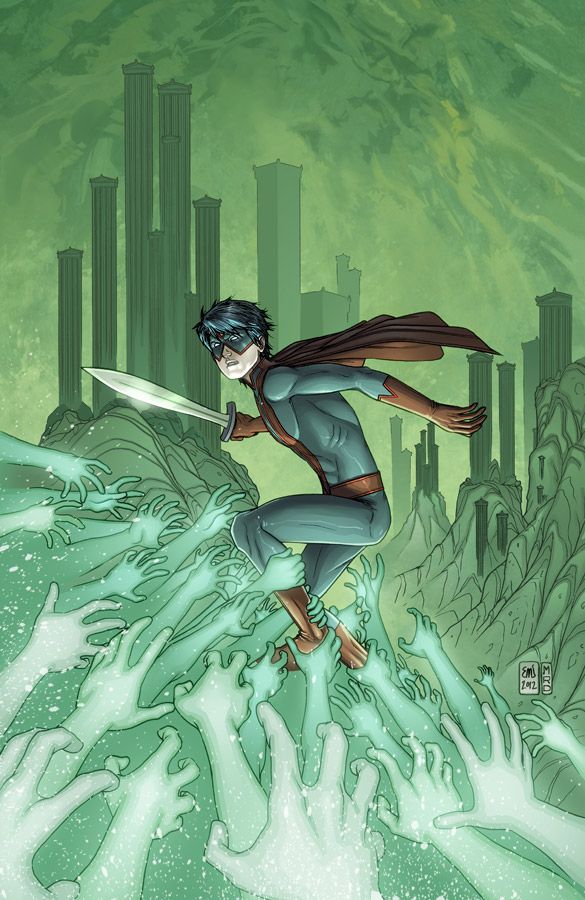Independent comics are vastly different from comics published by the likes of Marvel and DC in one major way: Fill-in creators are rarely, if ever, an option. If a creator cannot make his or her deadline that month, the issue is delayed. The creative team of Image’s Danger Club — writer Landry Walker, artist Eric Jones and colorist Rusty Drake — recently announced an upsetting and reasonable cause for the delay in the release of the fourth issue. As detailed on Walker’s blog: “Several weeks ago two of colorist Michael (Rusty) Drake’s kids were hit by a truck while riding their bikes home from the store. The short version is that they are both okay. The longer version is that Rusty’s son suffered a brain contusion and his daughter an injured ankle. This meant several days of stress and uncertainty. Things are better now, and both kids are home from the hospital and receiving continued treatment.”
While fortunately the children are recovering, Drake’s need to focus on his children’s care has not only delayed Issue 4, but has created a domino effect on the production of subsequent issues. The creative team is struggling to get back on schedule, and when I learned about the situation I offered to help them get the word out with an interview. Drake, a freelance creator with a full-time job and family demands, was unable to participate, but Walker and Jones were happy to discuss the delay and why there was never an option to proceed without Drake’s involvement in Danger Club. Also, while I had their attention, I decided to learn a little bit more about this dark series (a departure for the creative team) in which all the heroes left Earth for space to battle a horrific evil and never came back, leaving the teenage sidekicks to face the approaching danger.
But before diving into my questions, Landry wanted to stress one thing: “I should mention that Issue 4 is 100 percent complete. I haven't been told the date it will be released, but it should be only a few weeks, tops.” The creative team clearly appreciates the readers’ patience. As an outside observer, I hope this interview gives some perspective on the delay, as well as the struggles independent creators face.
Robot 6: First off, and most importantly, how are Rusty’s children doing (in terms of recovery from their injuries)?
Landry Walker: They’re doing very well considering the circumstances. Fortunately, they were cleared of the critical concerns after only a few days. Now it’s just a matter of their bodies healing themselves. They’re strong kids. They should be 100 percent, given a bit of time.
Eric Jones: It was a scary few days there when we were hearing terms like "critical condition,” and obviously we were much more concerned with their well-being than with the deadline for the comic, but thankfully they're doing much better now. Now we get back to work and do what we can to catch up.
It's important to note, unlike DC or Marvel, with an independent creative collaboration like this project, there's no consideration given to using a fill-in colorist. And, even, if that was an option, no one on the creative team would have considered that?
Landry: Circumstances play a big part. There were a few pages that we had help with on Issue 3, but those were very specifically discrete scenes where slight deviations from the look wouldn’t be noticed. Even then, Rusty oversaw the production on those pages. In this situation, the time it would have taken Rusty to manage this process would have offset any benefit of us saying, “Don’t worry about the schedule. Take care of your kids first”.
The three of us have been working on comics together since we were in our teens. At some point, deadlines do not come first.
Eric: Rusty's an integral part of the creative team on this book, and I can't even imagine hiring a fill-in for him. His work is as important to the look of the comic as my own, and frankly he does things that most colorists won't or can't. He puts a huge effort into every single page, and if we brought in a pinch-hitter, just about anybody else's work would stand out like a sore thumb against the rest of the series. That isn't to say there aren't other brilliant colorists out there, but Rusty's work is so unique that it would be impossible to replace him.
Not every comics consumer has an understanding of the struggles that an independent creator encounters in normal times, much less when a family emergency like this hits. How much did the accident impact the production schedule of Danger Club so far?
Landry: In truth, we were already running close to the edge. We all have “day jobs,” and getting paid on this kind of book … it’s akin to gambling. So our margin for error is quite small. You produce a book like this in your spare hours and hope everything goes perfect. So it should be noted that Rusty has managed his time very well despite the accident. But we were at a point where a small delay has repercussions.
Eric: We're going to do everything we can to steer the ship back on course, but I think everybody should expect delays for a while. Obviously I don't think Landry or I would be willing to put a specific time frame on when we're completely out of the woods; when it comes to recovery from injuries and everything that entails, it's a matter of hoping for the best and continuing forward.
What makes Rusty's coloring style so critical to this project -- and so effective in terms of its impact on Eric's art?
Landry: I think the reviews speak for themselves. Rusty adds a tremendous amount of depth and emotion to the work. People instantly took notice of the colors and online comments about them when discussing the work are common.
Beyond that, it’s his book, too. His name on the cover with ours.
Eric: Agreed. We work with Rusty every day, and his input is vital to the series overall -- he's absolutely directly involved in the creative process, and he has a voice in the book.
How supportive has Image been about the unavoidable delay?
Landry: Very. I mean, no one likes having a book come out late. It’s a very serious source of frustration in this industry. But at the same time, they have been extremely patient and helpful in keeping the book on track as much as is possible.
For those unfamiliar with Danger Club, the series is a notable departure from what you’ve been known for in recent years (all ages) -- and a chance to do a some darker storytelling. Landry, I enjoyed a recent interview moment where you half-jokingly described the series as being about "death and war." How much fun has it been to get to go darker?
Landry: Ultimately, I love doing fun comics. And all kinds of comics can be fun. While Danger Club is a heavy book, it’s very much a superhero book with all the trappings that come from a superhero universe. Additionally, it is very specifically a commentary on “grim” comics -- a trait that is alluded to in Issue 3 and will become clearer as the story progresses.
Eric: Doing "dark" comics is really fun from an artist's perspective; it's an opportunity to do some much more visceral, intense imagery. But I love cartooning too -- in fact, I plan on doing some more cartoony work sometime shortly after finishing Danger Club -- I really hate it when people try to suggest that "dark" comics are somehow superior to all-ages comics. It's just a different animal, and too many people refuse to give it its due.
Part of the solicitation for Issue 6 includes the opening phrase "As all of reality collapses ..."-- narrative-wise as well as artistically how challenging is it to convey the collapse of reality on a printed page?
Landry: Oh, it’s quite easy. You just write: “All of reality collapses.” The rest seems to take care of itself!
Eric: It should be noted that I hate Landry's guts, by the way.
With three issues under your belt and many more to come, are you seeing certain members of the cast resonating with readers more than you may have originally expected?
Landry: We knew that a subsection of readers would gravitate towards Yoshimi. Same with Kid Vigilante, simply due to the character's single-minded intensity. After Issue 4, it will be interesting to see how people feel about the Magician and Jack …
It’s tricky. Obviously you don’t know anyone on page one of Issue 1, yet you kind of do. Many readers enjoy this slow unveiling of character. But I think other readers have trouble with the fact that we didn’t open with a Who’s Who-style caption on everyone.
Eric: It's been really interesting to watch the commentary online, with people picking out certain traits of a character, and then declaring that character our analog for whichever well-known hero from Marvel or DC. In some cases they're right, but they're often mistaken. I think it's fair to say that some of our characters are conglomerations of various preexisting characters, while some are analogous to a specific character, and others are neither.
During Comic-Con International you guys were offering some cool limited-edition prints for sale (a different one for each day). How quickly did they get scooped up -- and will you be doing another offer like that down the road? Do you think the prints also helped get the word out about the series?
Landry: They sold well, but we weren’t as aggressive as we should have been in advertising our presence. So we’ve got a small stack left. The response was good though. We will be producing prints of the first page of each issue.
Eric: Actually, there are only a couple left! And they're EXTREMELY VALUABLE! Contact me for more info.
Anything we should discuss that I neglected to ask you about?
Landry: Our comic series Little Gloomy/Super Scary Monster Show is airing in Europe every day of the week as a cartoon.
Eric: So, European readers: Check out Scary Larry on the Canal+ Family Channel!
Is there any plans for it to air in the United States?
Landry: Little Gloomy was adapted into animation by 1492 Pictures (the people who did the first few Harry Potter movies) in conjunction with a French animation studio. There initial goal is European distribution. I imagine U.S. distribution will follow shortly.



